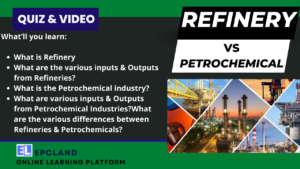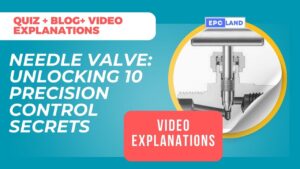1. What is the primary purpose of a ball valve?
Choose the correct option that best describes the primary function of a ball valve.
Explanation: The primary purpose of a ball valve is for fully open/closed applications, making option C the correct answer.
2. In which type of applications are ball valves well-suited?
Select the options that correctly describe the recommended uses of ball valves.
Explanation: Options A (Fully open/closed applications) and B (Limited throttling applications) are the recommended uses of ball valves.
3. What is a disadvantage of ball valves?
Identify the correct disadvantage associated with the use of ball valves.
Explanation: The correct disadvantage of ball valves is poor throttling characteristics, making option B the correct answer.
4. How is manual operation achieved in a ball valve?
Choose the correct method used for manual operation of ball valves.
Explanation: Manual operation of a ball valve is accomplished through a quarter-turn handle, making option B the correct answer.
5. What type of actuators can be used to automate ball valves?
Select the correct options regarding the automation of ball valves.
Explanation: Pneumatic and electric actuators can be used to automate ball valves, making options B and C the correct answers.
6. Why are ball valves not suitable for applications that require precise flow control?
Identify the specific reason why ball valves are not recommended for applications requiring precise flow control.
Explanation: The correct reason is poor throttling characteristics, making option B the correct answer.
7. In what type of applications should ball valves not be used?
Identify the specific application for which ball valves are not suitable.
Explanation: Ball valves should not be used for applications requiring precise flow control, making option C the correct answer.
Short Article on Basics of Ball Valves
Ball Valves
Ball valves are a type of valve that uses a sphere (ball) to control the flow of fluid. They are characterized by their low cost, high capacity, low leakage, and tight sealing. Ball valves are ideal for fully open/closed applications, as well as limited throttling applications. They are also well-suited for higher temperature fluids and slurries.
Recommended uses:
- Fully open/closed applications
- Limited throttling applications
- Higher temperature fluids
Applications:
- Most liquids
- High temperatures
- Slurries
Advantages:
- Low cost
- High capacity
- Low leakage
- Tight sealing with low torque
Disadvantages:
- Poor throttling characteristics
- Prone to cavitation
Manual operation is accomplished through a quarter-turn handle. Pneumatic and electric actuators can be used to automate ball valves.
Ball valves are a popular choice for a variety of applications due to their many advantages. However, it is important to note that they are not suitable for all applications. For example, they should not be used for applications that require precise flow control.
Table of Contents
Don’t miss the Course on Effective Isometrics Management: Check Now
Enrollment Link
Recommended courses (Published on EPCLand)
- Complete Course on Piping Engineering
- Basics of Piping Engineering
- Piping Layout Engineering
- Piping Material Engineering
- Piping Stress Analysis
- Material Requisitions
- Piping Material Specifications
- Valve Material Specifications
- Plant Design & Layouts-OISD 118
- Isometric Management
Library of Technical Articles
Don’t miss out the collection of 15+ articles on following topics:
- Basics of Oil and Gas Industry
- Valves
- Testing
- Tank
- Piping Bulk Items
- Pipe
- Metallurgy
- Piping Materials
- Layout
- Instrumentation
- Heat Exchanger
- Type of Contracts
- Codes and Standards
- ASTM Standards
- Articles on Piping Specialty Items
Video details of Complete Course on Piping Engineering
Why Enroll in the EPCLand
Proven Track Record– PTR
Activities & Achievements before launching EPCLand
- Published more than 50+ short courses
- 3000+ Enrolments
- More than 3,500,00 Minutes of watch hours in the last 2 years
- 4000+ Students in 100+ Countries
- Rating of 4+ out of 5
- 1000+ YouTube Videos
- 8K+ Subscribers
What Students will Learn
- Codes & Standards of the Energy Sector
- Piping Material Engineering
- Piping Layout Engineering
- Stress Analysis
Interesting facts
- All the published courses have been developed by Industry Experts with more than 2 decades of experience
- Content is based on Practical experience and real-time problems.
- Content is designed and organized in such a manner that it can be easily grabbed.
- Complete website, Blogs and Quiz sections are Planned, Designed and published by myself (About me: Atul Singla)
- Complete flexibility of Time & Location, Students can access the content from anywhere & anytime
- Moreover, once enrolled, the content can be access as many times as you want, which helps in understand the fundamentals in a better way.
Conclusion
In conclusion, our courses are meticulously crafted by industry experts with over two decades of hands-on experience. The content is rooted in practical knowledge, addressing real-time problems. The material is thoughtfully designed and organized for easy comprehension. Every aspect, from the website to blogs and quizzes, has been planned, designed, and executed by Atul Singla, ensuring a comprehensive and seamless learning experience. With the flexibility of accessing the content at any time and from any location, students have the freedom to learn on their terms. Furthermore, enrollment grants unlimited access, allowing learners to revisit the material as often as needed, fostering a deep understanding of the fundamentals.



